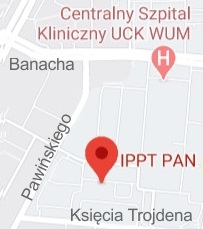| Ichiro Ario |
|
Ostatnie publikacje
| 1. |
Keigo Y.♦, Ario I.♦, Zawidzki M., Yuta H.♦, Optimization Problem of the size-scale for a Foldable Chain Scissors Structure based on Stress Analysis,
Journal of Physics: Conference Series, ISSN: 1742-6596, DOI: 10.1088/1742-6596/2647/4/042005, Vol.2647, pp.1-9, 2024 Streszczenie: Słowa kluczowe:
| 40p. | |||||||||||||||||||||||||
| 2. |
Ario I.♦, Yamashita T.♦, Chikahiro Y.♦, Nakazawa M.♦, Fedor K., Graczykowski C., Pawłowski P., Structural analysis of a scissor structure,
BULLETIN OF THE POLISH ACADEMY OF SCIENCES: TECHNICAL SCIENCES, ISSN: 0239-7528, DOI: 10.24425/bpasts.2020.134623, Vol.68, No.6, pp.1-14, 2020 Streszczenie: Słowa kluczowe:
| 100p. | |||||||||||||||||||||||||
| 3. |
Chikahiro Y.♦, Ario I.♦, Pawłowski P., Graczykowski C., Holnicki-Szulc J., Optimization of reinforcement layout of scissor-type bridge using differential evolution algorithm,
Computer-Aided Civil and Infrastructure Engineering, ISSN: 1093-9687, DOI: 10.1111/mice.12432, Vol.34, No.6, pp.523-538, 2019 Streszczenie:
| 140p. | |||||||||||||||||||||||||
| 4. |
Chikahiro Y.♦, Ario I.♦, Nakazawa M.♦, Ono S.♦, Holnicki-Szulc J., Pawłowski P., Graczykowski C., Watson A.♦, Experimental and numerical study of full-scale scissor type bridge,
Automation in Construction, ISSN: 0926-5805, DOI: 10.1016/j.autcon.2016.05.007, Vol.71, pp.171-180, 2016 Streszczenie: Słowa kluczowe:
| 40p. |
Lista rozdziałów w ostatnich monografiach
|
1. |
Chikahiro Y.♦, Ario I.♦, Nakazawa M.♦, Ono S.♦, Holnicki-Szulc J., Pawłowski P., Graczykowski C., Mobile and Rapidly Assembled Structures IV, rozdział: An Experimental Study On The Design Method Of A Real-sized Mobile Bridge For A Moving Vehicle, N. De Temmerman,Vrije, C.A. Brebbia, WITPress, pp.93-106, 2014 |
Prace konferencyjne
| 1. | Zawidzka E., Chikahiro Y.♦, Ario I.♦, Extremely Modular Arm-Z manipulator, The 5th National Convention of the Japan Society of Civil Engineers, 2023-09-14/09-15, Hiroshima (JP), pp.1-2, 2023 | |||||||||||||||||||||||
| 2. | Zawidzki M., Ario I.♦, Extremely Modular Truss-Z Pedestrian Ramp, The 5th National Convention of the Japan Society of Civil Engineers, 2023-09-14/09-15, Hiroshima (JP), pp.1-2, 2023 | |||||||||||||||||||||||
| 3. |
Yoshida K.♦, Ario I.♦, Zawidzki M., Hama Y.♦, Optimization Problem of the size-scale for a Foldable Chain Scissors Structure based on Stress Analysis,
EURODYN2023, 2023-07-02/07-05, Delft (NL), pp.1-9, 2023 Streszczenie:
| |||||||||||||||||||||||
| 4. |
Chikahiro Y.♦, Ario I.♦, Pawłowski P., Graczykowski C., Nakazawa M.♦, Holnicki-Szulc J., Ono S.♦, Dynamics of the scissors-type Mobile Bridge,
EURODYN 2017, X International Conference on Structural Dynamics, 2017-09-10/09-13, Rome (IT), DOI: 10.1016/j.proeng.2017.09.339, Vol.199, pp.2919-2924, 2017 Streszczenie: Słowa kluczowe:
| 20p. | ||||||||||||||||||||||
| 5. |
Chikahiro Y.♦, Ario I.♦, Adachi K.♦, Shimizu S.♦, Pawłowski P., Graczykowski C., Holnicki-Szulc J., Fundamental study on dynamic property of deployable emergency bridge using scissors mechanism,
Footbridge Berlin 2017, 6th International Footbridge Conference, 2017-09-06/09-08, Berlin (DE), DOI: 10.24904/footbridge2017.09352, pp.1-6, 2017 Streszczenie: Słowa kluczowe:
| |||||||||||||||||||||||
| 6. |
Pawłowski P., Graczykowski C., Holnicki-Szulc J., Ario I.♦, Smart, deployable skeletal structures for safety engineering,
SMART2013, 6th ECCOMAS Thematic Conference on Smart Structures and Materials, 2013-09-03/09-06, Turyn (IT), pp.1-10, 2013 Streszczenie: Słowa kluczowe:
|
Abstrakty konferencyjne
| 1. |
Ario I.
♦, Ma D.♦, Ma H.♦,
Zawidzki M., Advanced Bifurcation Analysis Using Modified Stiffness Method of Group Theoretic Imperfections,
ICTAM 2024, The 26th International Congress of Theoretical and Applied Mechanics, 2024-08-25/08-30, Daegu (KR), pp.1-2, 2024 Streszczenie: Słowa kluczowe:
| |||||||||||||||||||||||||
| 2. | Zawidzki M., Ario I.♦, The 5th National Convention of the Japan Society of Civil Engineers, JSCE 2023, JSCE Japan Society of Civil Engineers 2023 Annual Meeting, 2023-09-14/09-15, Hiroshima (JP), pp.1-3, 2023 | |||||||||||||||||||||||||
| 3. | Chikahiro Y.♦, Ario I.♦, Pawłowski P., Graczykowski C., Shimizu S.♦, Numerical Optimization of Deployable Scissors Structure with Reinforcing Chord Members, SolMech 2018, 41st SOLID MECHANICS CONFERENCE, 2018-08-27/08-31, Warszawa (PL), pp.370-371, 2018 | |||||||||||||||||||||||||
| 4. | Chikahiro Y.♦, Ario I.♦, Pawłowski P., Graczykowski C., Nakazawa M.♦, Holnicki-Szulc J., Ono S.♦, Dynamics of the scissors-type Mobile Bridge, EURODYN 2017, X International Conference on Structural Dynamics, 2017-09-10/09-13, Rome (IT), pp.199-199, 2017 | |||||||||||||||||||||||||
| 5. |
Chikahiro Y.♦, Ario I.♦, Adachi K.♦, Shimizu S.♦, Pawłowski P.♦, Graczykowski C.♦, Holnicki-Szulc J.♦, Fundamental study on dynamic property of deployable emergency bridge using scissors mechanism,
Footbridge Berlin 2017, 6th International Footbridge Conference, 2017-09-06/09-08, Berlin (DE), pp.1-6, 2017 Streszczenie: Słowa kluczowe:
| |||||||||||||||||||||||||
| 6. |
Chikahiro Y.♦, Ario I.♦, Adachi K.♦, Shimizu S.♦, Zenzai S.♦, Pawłowski P., Graczykowski C., Holnicki-Szulc J., Fundamental study on dynamic property of scissoring bridge for disaster relief,
ENOC 2017, 9th European Nonlinear Dynamics Conference, 2017-06-25/06-30, Budapest (HU), pp.1-2, 2017 Streszczenie:
| |||||||||||||||||||||||||
| 7. |
Chikahiro Y.♦, Ario I.♦, Holnicki-Szulc J., Pawłowski P., Graczykowski C., A Study on Optimal Reinforcement of Scissor Type of Bridge with Additional Strut Members,
ICCEE 2016, International Conference on Civil and Environmental Engineering, 2016-10-17/10-19, Hiroshima (JP), pp.1-2, 2016 Słowa kluczowe:
| |||||||||||||||||||||||||
| 8. |
Chikahiro Y.♦, Ario I.♦, Nakazawa M.♦, Ono S.♦, Holnicki-Szulc J., Pawłowski P., Graczykowski C., Structural Analysis and Experimental Study for realsized MB Travelable Vehicles,
ENOC 2014, 8th European Nonlinear Dynamics Conference, 2014-07-06/07-11, Wiedeń (AT), pp.1-2, 2014 Streszczenie: Słowa kluczowe:
| |||||||||||||||||||||||||
| 9. |
Holnicki-Szulc J., Graczykowski C., Pawłowski P., Ario I.♦, High Performance Valve for Adaptive Pneumatic Impact Absorbers,
SolMech 2012, 38th Solid Mechanics Conference, 2012-08-27/08-31, Warszawa (PL), pp.1-2, 2012 Streszczenie: Słowa kluczowe:
|
Patenty
|
Numer/data zgłoszenia patentowego Ogłoszenie o zgłoszeniu patentowym |
Twórcy Tytuł Kraj i Nazwa uprawnionego z patentu |
Numer patentu Ogłoszenie o udzieleniu patentu |
|
|---|---|---|---|
|
14895015.7 2014-06-17 WO2015193930 2015-12-23 |
Ario I.♦, Tanaka Y.♦, Chikahiro Y.♦, Nakatani S.♦, Tanikura I.♦, Ono S.♦, Akamatsu T.♦, Sato T.♦, Hanaki S.♦, Nakamura S.♦ Scissors-type retractable structure EPO, Hiroshima University, Sankyo Tateyama, Inc., Hoshikei Kinzoku Kogyo Co., Ltd., Japan Construction Machinery and Construction Association, Institute of Fundamental Technological Research Polish Academy of Science |
EP3147407 Bulletin 2019/32 2019-08-07 |
|
















